

Time to make a prediction; dangerous though that may be!
Looking around various orchards this week, taking in Cherries, Plums, Apples & Pears, it is clear we do not have all the answers yet; in fact we were 'joking' today that the 'old addage' of 'waiting until Derby Day' to assess the crop, should be postponed this year until Royal Ascot!
Apples are patchy, with Gala the most promising of the main varieties. Braeburn and Bramley are much more patchy. Cox varies from good, to very light. Jazz, Kanzi and Rubens look promising. "Generally the orchards that came into blossom later and caught the better weather have set very well". Some varieties have been influenced by the weight of last year's crop and the timing of picking; e.g. if early the blossom was stronger and if picked late, the blossom was weaker and this has influenced the fruit set this year.
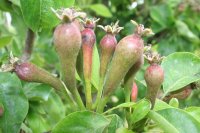 Pears are beginning to sort themselves out, but are still generally at the 'upright' stage, although some fruitlets are clearly about to drop off. We will not have a clear picture until they 'turn over'
Pears are beginning to sort themselves out, but are still generally at the 'upright' stage, although some fruitlets are clearly about to drop off. We will not have a clear picture until they 'turn over'
The blossom period was very drawn out, and typically many Bramley orchards have a range of fruitlet sizes, due to early blossom set, later blossom set, and 'secondary blossom' is still appearing. This will create a wide range of sizes at harvest unless judicious thinning is carried out.
The predictions made by The EAM in the Journal for 11th May. were very accurate!
Quote: The potential for a 'fruit set' is still very much 'in the air' and it seems likely there will be 'winners and losers' with the variable conditions from 'day to day' and 'orchard to orchard' but, with the knowledge that 'it only needs one fine day' to set an apple crop. However, while that may be true, that one day needs to be when the blossom is 'ripe' for pollen release and pollinating insects are 'on duty' after that the temperature is critical for fertilization of the ovary. Some really warm days would help!
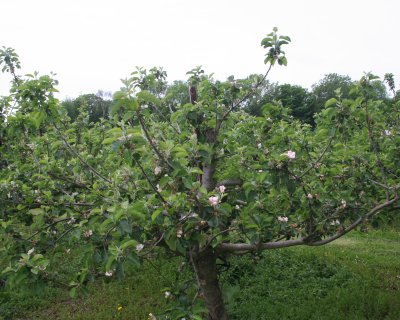
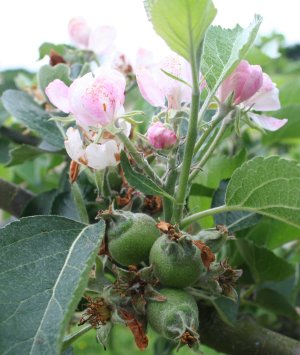
Cherries (as reported last week) should produce an ample crop, while Plums vary from site to site, with some patchy, the majority with a good set which will not need as much thinning and some orchards very heavy and in need of severe thinning!
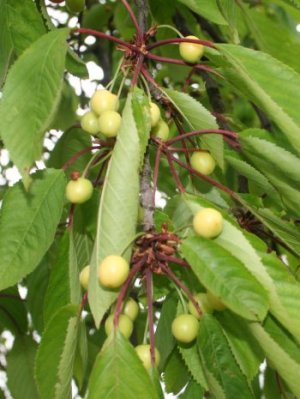
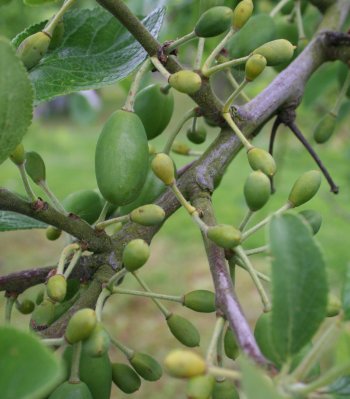
REDLOVE® APPLES
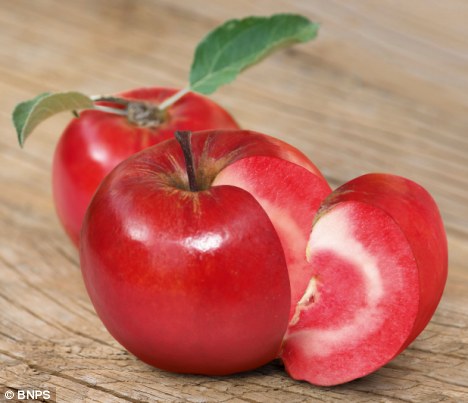 In The English Apple Man Journal for 17th September 2010 the concept of a red fleshed apple was featured.
In The English Apple Man Journal for 17th September 2010 the concept of a red fleshed apple was featured.
An extract from The English Apple Man Journal for 17th September 2010 explains the marketing agreement for commercial use of Redlove® 'trade mark' as Suttons hold the license for garden nursery sales of the trees and A.G.Thames the commercial license.
"At Suttons Seeds press day at Hadlow College last year A.G.Thames Michelle Absalom ~ Managing Director of Chingford Fruit Ltd. announced their exclusive marketing rights for Redlove as a commercial concept. Michelle announced a strategic planting and marketing initiative designed to put Redlove into Sainsburys Supermarkets in 3 years time"
I used the word concept, because Redlove® is not a specific variety, but several, bred by Marcus Kolbert to start marketing in mid August through a period of several months.
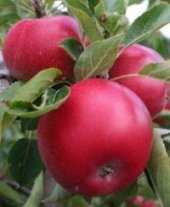 Consumers will be aware that early varieties e.g. Discovery do not store well and are soon followed by mid season varieties, for example Worcester Pearmain (traditional variety) or Early Windsor (modern variety) before supply moves onto true main crop varieties like Cox and Gala.
Consumers will be aware that early varieties e.g. Discovery do not store well and are soon followed by mid season varieties, for example Worcester Pearmain (traditional variety) or Early Windsor (modern variety) before supply moves onto true main crop varieties like Cox and Gala.
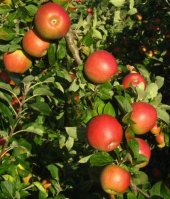 The Redlove® concept is intended to give the consumer an opportunity to purchase a red fleshed apple with good flavour and texture under the banner of Redlove® as one variety seamlessly follows another.
The Redlove® concept is intended to give the consumer an opportunity to purchase a red fleshed apple with good flavour and texture under the banner of Redlove® as one variety seamlessly follows another.
Suttons Seeds hold the marketing rights for Redlove® Apple Trees.
Below an extract from their website;
Redlove® boasts long-lasting and unusual deep pink blossom, and unique fruit that is dark red, both outside and inside, revealing a beautiful pattern when you slice through it. The juicy, fragrant flesh has a texture that can be likened to a Cox, but with an extra range of subtle cherry fruit flavours. A delicious eater, it is also ideal for cooking (it retains its red colour). Try it in fruit salads (it doesn't turn brown), pies, puddings and tarts. Or simply enjoy a glass of mouth-watering freshly squeezed juice!
Eat apples straight from the tree or store until the end of October. Supplied as a top quality bare root tree.
Redlove® is a protected trademark belonging to Lubera AG, Switzerland.
Suttons add; The Redlove® that we offer is protected and buyers of the trees are allowed to grow the trees only for their private use. Buyers are not allowed to use the trees for commercial purposes (ie to grow for the fruit market or to multiply these trees or to sell fruit of the Redlove varieties under the Redlove® trademark nor under another name).
Reviewing the comments from the launch in September 2010; Suttons only hold the tree rights for the home nursery market. A.G.Thames hold the commercial planting and marketing rights for Redlove® for the whole of the UK.
On Tuesday, after a very wet April held up proceedings, the weather finally allowed the planting of an exciting new venture as the first commercial Redlove® Orchard in England was planted at East Malling Research. This new venture is fully funded by A.G.Thames with EMR contracted to supply the 'growing expertise'
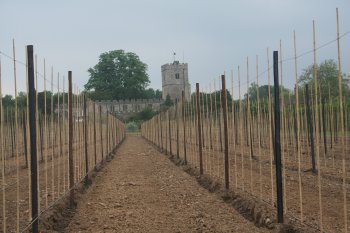
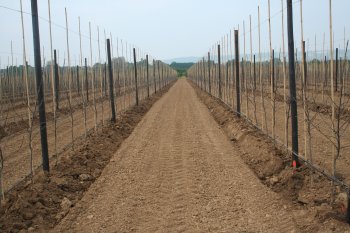
The English Apple Man popped in during the afternoon to take pictures of the planting process. It was quite staggering as the team planted in excess of 7,600 trees, covering a little over 3 hectares in one day!
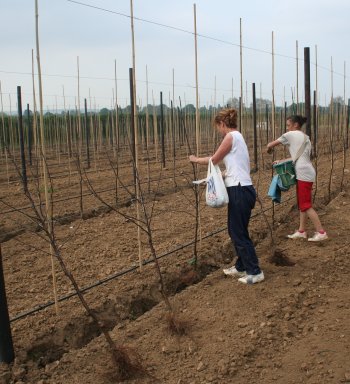
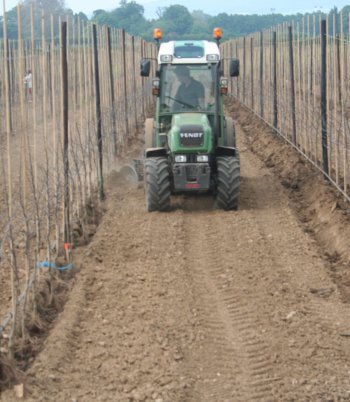
Not quite the way we did it in my younger days, but a jolly sight easier as a combination of modern machinery and well thought out procedures made the whole process a 'smooth operation'
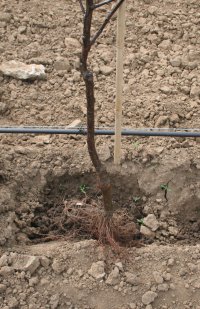 The
The 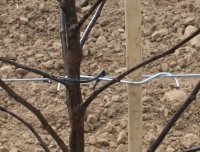 stakes, wirework, canes and irrigation were all in place ahead of the planting process, and a trough is prepared (mechanically) in readiness; the trees are placed into the trough where water from the drip irrigation lines moistens the soil and team members secure each tree with a novel tree tie, before the soil is mechanically moved back around the trees.
stakes, wirework, canes and irrigation were all in place ahead of the planting process, and a trough is prepared (mechanically) in readiness; the trees are placed into the trough where water from the drip irrigation lines moistens the soil and team members secure each tree with a novel tree tie, before the soil is mechanically moved back around the trees.
The rows are 3 metres apart and the trees 1 metre apart in the rows. Each tree has a bamboo cane to add support. There are three different clones of Redlove which will mature in succession, spreading the picking period over a few weeks. The harvest period will run from late August and the fruit can be held in cold storage allowing an extended marketing period.
The young trees are well furnished with 'feathers' (young branches) and fruit bud will be laid down during the growing season ahead, resulting in a crop of apples next year........
Francis Wheatley; A.G.Thames Technical Manager... "expects the first Redlove® apples to be on sale in Sainsburys during September 2013..... Redlove® has the potential to be used as a fresh and processed product".
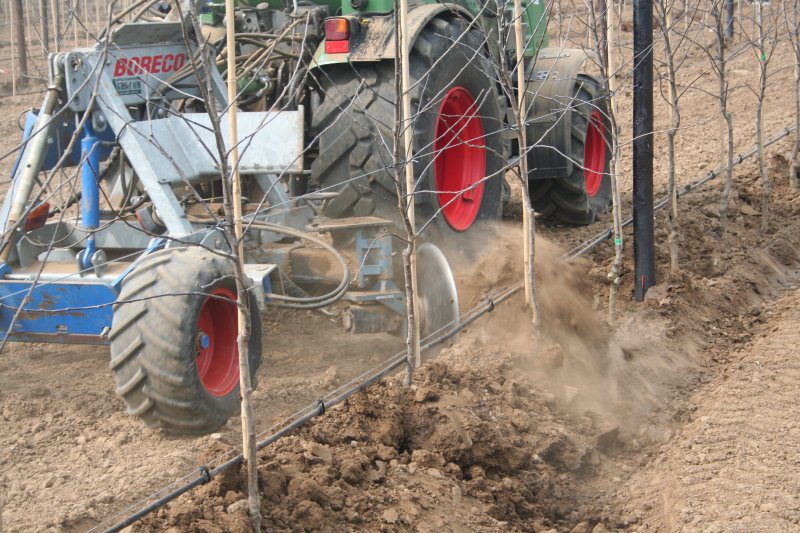
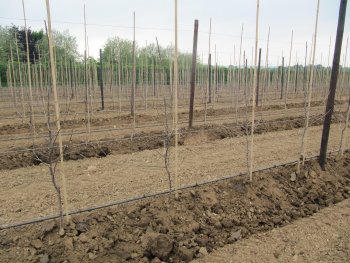 The Redlove Apple is the result of 20 years of painstaking work by Swiss grower and breeder Marcus Kobert. He has cross-pollinated a number of varieties - including one that has pink flesh but no taste - to come up with the Redlove.
The Redlove Apple is the result of 20 years of painstaking work by Swiss grower and breeder Marcus Kobert. He has cross-pollinated a number of varieties - including one that has pink flesh but no taste - to come up with the Redlove.
Markus Kobert, a Swiss fruit grower.
Seed and sapling company Suttons has secured exclusive rights to sell the fruit trees in Britain, with 1,500 orders taken from amateur gardeners already.
Orchards across Europe are being planted with saplings so the apples can be produced on a commercial scale. British supermarkets are expected to start selling them within the next few years.
Quite apart from the visual attraction of the 'red flesh' the major benefit for health conscious consumers is the much higher level of antioxidants in the red flesh. As we are so often told by health promotion agencies, antioxidants are key to our well being;
Antioxidant Nutrients
Antioxidants from our diet appear to be of great importance in controlling damage by free radicals. Each nutrient is unique in terms of its structure and antioxidant function.
Vitamin E is actually a generic term that refers to all entities (eight found so far) that exhibit biological activity of the isomer tocopherol (an isomer is one of two or more molecules that have the same chemical formula but different atomic arrangements).
Alpha-tocopherol, the most widely available isomer, has the highest biopotency, or strongest effect in the body. Because it is fat-soluble (and can only dissolve in fats), alpha-tocopherol is in a unique position to safeguard cell membranes -- largely composed of fatty acids -- from damage by free radicals. Alpha-tocopherol also protects the fats in low-density lipoproteins (LDLs, or the "bad" cholesterol) from oxidation.
Vitamin C, also known as ascorbic acid, is a water-soluble vitamin. As such, it scavenges free radicals that are in an aqueous (watery) environment, such as inside your cells. Vitamin C works synergistically with vitamin E to quench free radicals. Vitamin C also regenerates the reduced (stable) form of vitamin E.
Beta-carotene, also a water-soluble vitamin, is the most widely studied of the 600 carotenoids identified to date. It is thought to be the best quencher of singlet oxygen (an energized but uncharged form of oxygen that is toxic to cells). Beta-carotene is also especially excellent at scavenging free radicals in low oxygen concentration.
Selenium is a trace element. It is a mineral that we need to consume in only very small quantities, but without which we could not survive. It forms the active site of several antioxidant enzymes including glutathione peroxidase.
Similar to selenium, the minerals manganese and zinc are trace elements that form an essential part of various antioxidant enzymes.
In theREDLOVE LINK Marcus Kobert explains how in a long and complex operation, he crossed and re-crossed a red fleshed apple with other varieties until he produced a seedling variety with red flesh AND good taste and texture.
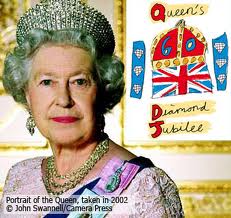 Our Queen's Diamond Jubilee.
Our Queen's Diamond Jubilee.
All over the country, and no doubt throughout the commonwealth, this 'extended' Bank Holiday weekend will see some very spectacular events celebrating our Queen's Diamond Jubilee. In addition to many street parties, our village of Robertsbridge is organising a "Jubilympics" making the most of an opportunity for a 'double' celebration with a series of 'pseudo Olympic' activities.
Passing through the 'delightful' Wealden Village of Goudhurst on Tuesday evening, I came across the preparations for their village celebrations and stopped to catch the scene on camera.
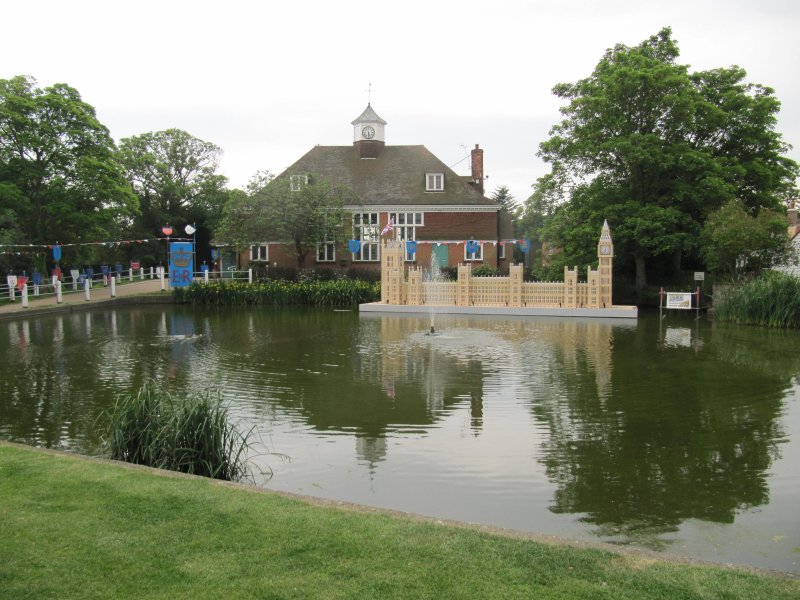
Westminster on the Goudhurst Pond. It illuminates at night and Big Ben 'works'
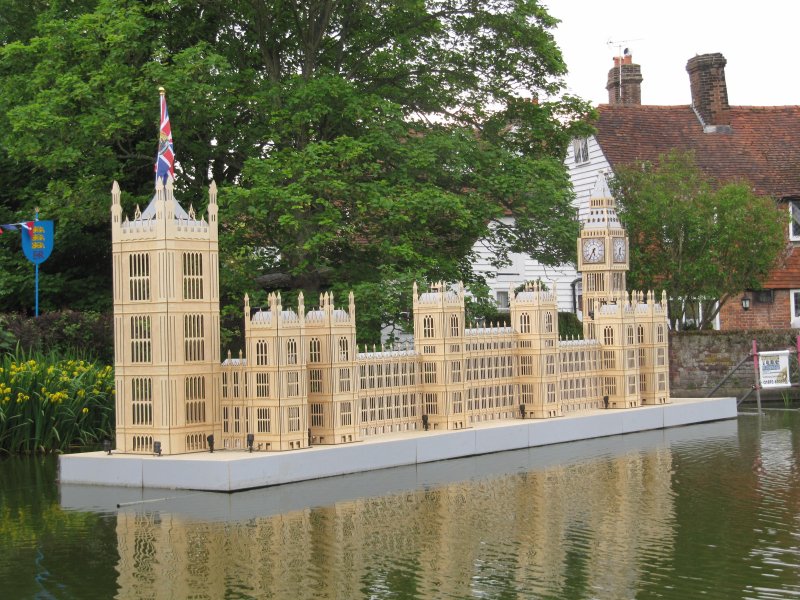
To all my readers, have a great Jubilee weekend.......
Take care
The English Apple Man